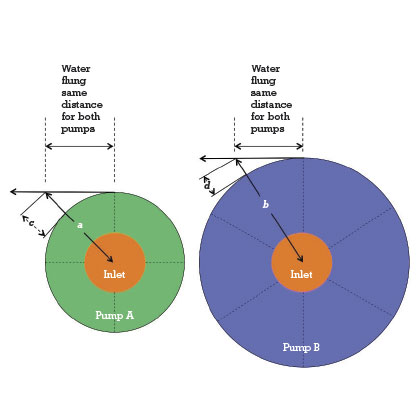Conventional centrifugal water pumps are unable to be significantly improved; however the Stelth “Solid Body Vortex” principle, employed as a pump, approaches the problem from an entirely different direction by employing a vortex.
Strobing of freely rotating “sails” within the disc shaped vortex reveals the water does not undergo shear either radially or axially. Diffusion, at approximately 4,900 feet per second, sonic for water, re-distributes fluid and pressure virtually instantly.

The water vortex disc shape is formed by a short window it repeatedly passes through, the only hard surface the vortex contacts. The vortex cannot enlarge or thicken due to its high speed. Standard rpms of 56 revolutions per second indicate about 95 feet per second of the vortex periphery. Much higher rpms are also being exploited. The vortex rpm lags behind the impeller rpm slightly as impeller and vortex try to be one.
Water is forced by diffusion out of the disc shaped vortex, across an invisible dynamic wall, into a body of water that is slowing between the vortex periphery and pump casing inner wall. That slowing body acts similarly to the diffuser of a conventional volute pump. No cutwater means no water wake collisions. 9dBA noise reduction, 8 times quieter than conventional pumps, has been measured. This is the only pump where two extremely different speeds of water co-function within one pump casing.
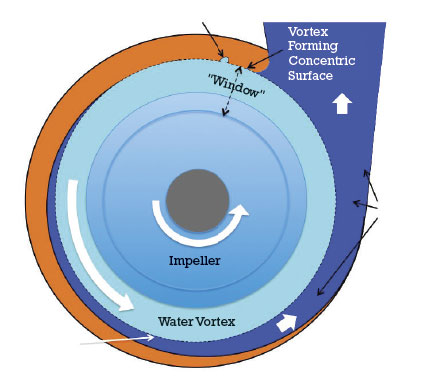
Featured image: Distance a in pump A is shorter than distance b in pump B. At same periphery speed, periphery of pump A has receded distance c while periphery of pump B has receded distance d. The larger rate of recession of pump A (61.5%) represents a larger acceleration generating much larger force. 1.615 squared = 2.6 times dynamic pressure from pump A over pump B, much of which is converted to static head.
The water vortex periphery speed is about 20 percent higher than the impeller periphery speed. With a solid body vortex, water molecules line up like wheel spokes. The rim goes faster than the hub.
Water vortex cannot grow in diameter or thicken due to very high speed.
The test results show a significantly higher Best Efficiency Point (BEP) than conventional pumps.
At the same system resistance as competitors, the Stelth delivers more gallons per watt-hour. This is more important than merely best efficiency point (BEP) comparisons because it indicates electricity savings.
Freely rotating “sails” are strobed through a clear pump casing. The sails set relative to each other demonstrating that there is no shear between the water molecules.
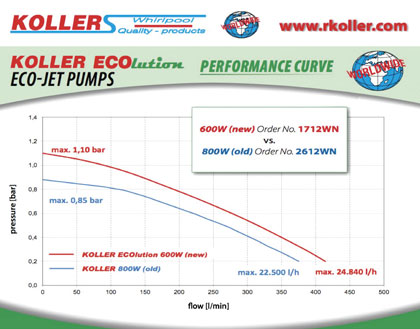
From the Koller brochure. Red curve is the Stelth pump.
The Stelth efficiency curves are broader than conventional, showing better overall energy efficiency for changing system resistance such as in filtration (pools, industrial, etc.), automotive engine cooling, and bilge applications.
Higher rpm than induction motor speeds at very small diameter delivers even larger increases in performance.
Centrifugal pumps cannot run at much higher rpm than that controlled by the alternating current frequency from the power station, 60 cycles (60 Hertz) 3,600 rpm. As conventional pump impeller speed significantly increases over conventional, the water wakes collide with the cutwater of a volute pump or the diffuser inlets of a pool pump, resulting in cavitation with loss of efficiency and extreme noise.
The Stelth pump has no cutwater or conventional diffusers. It can run up to extremely high rpm with efficiency, pressure, and output increasing as the rpm increases. At 6,000 rpm it is barely audible. Conventional centrifugal pumps will never be able to do this even with higher rpm motors.
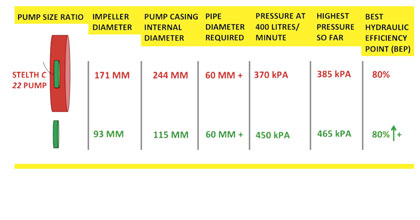
6000 rpm (green) Stelth pump, enabled by Brushless variable speed DC Motors, outperforms a much larger and also highest efficiency pump. The larger red Stelth Pump exceeds the Chinese Government’s highest efficiency requirements while powered by a conventional 2900 rpm induction motor. One stage of the small Stelth pump also outperforms a conventional 4-stage pump.
A second reason for not increasing rpm of conventional pumps is that the conventional induction motors run at the compromise speed the power station dictates. Fifty cycles gives 3,000 rpm in Europe and much of Asia and sixty cycles, 3,600 rpm in USA.
This is worldwide compromise because the iron in the motors cannot switch magnetic polarity much faster than that and is also subject to hysteresis losses. That is why motors and most appliances, such as pumps, have grown up together.
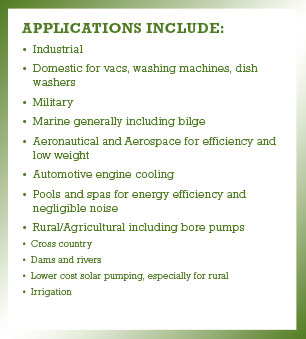
The Stelth pumps high rpm advantage has been trialled at a leading Australian University powered by a new, high rpm, Amorphous Metal Motor.
Amorphous iron, used in the world’s most efficient transformers, can switch polarity extremely fast and reduce losses over conventional iron by ten times with the highest efficiency achievable and is now being developed as a motor, a thirty-year-long dream.
The best quality Amorphous iron is made by Metglas, wholly owned by Hitachi Metals America. The Metglas website explains the advantages of amorphous iron over standard iron. These advantages will begin to apply to motors and generators.
Geometry rules favour the Stelth pump. If you decrease the size of any object, the surface area increases relative to its internal volume. The surface area of pump A, relative to its internal volume, is 74 percent larger than the surface area of pump B relative to its internal volume. Extremely large pumps cannot find enough surface for ports and must have double inlets, meaning an inlet each side.
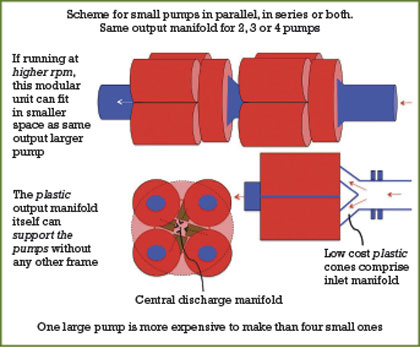
6,000 rpm, above, equals water vortex speed of nearly 100 revolutions per second yet noise is negligible.
Smaller size gives a favorable advantage for surface to volume ratio. Larger “recession” of a smaller impeller gives an advantage for pressure and efficiency.
For same water speed for pumps A and B,
- ”a” is further than “b”. Water is accelerated faster.
- “c” is further than “d”. This is also a greater acceleration off the impeller.
Acceleration is the source of all force. Larger acceleration results in more force.
The cost of any high speed brushless motors is largely offset by the lower cost of the small size Stelth pump when running at high rpm and the physically smaller motor. Far lower running costs re-coup investment quickly. It enables a tiny, energy dense package. This means running small pumps in parallel and or series has great advantages.
Four small plastic pumps can replace a much larger size pump that must be cast from metal, requiring a foundry, impeller balancing, large, high speed seals, and bearings.
The Stelth pump and any motor driving it can be smaller, lighter, quieter, higher pressure and efficiency, and lower cost to manufacture. Every category the Stelth pump has been applied to so far averages approximately 30 percent increase in energy efficiency indicating the same percentage reduction in dollar cost to run.
The Stelth concept is the biggest breakthrough yet in water movement. It outperforms other pumps while using conventional induction motors and also introduces the ability to run at very high rpm, using brushless DC, variable speed motors, delivering performance that no other pumps can. ◆
About The Author:
With core focus areas of fluid dynamics, vortex dynamics, and aerodynamics, New Fluid Technology is one of Australia’s leading research and development companies and holds numerous patents for products serving commercial applications in the industrial pump and fan markets. For more information, contact Terry Day at terryday1000@gmail.com.
____________________________________________
MODERN PUMPING TODAY, February 2016
Did you enjoy this article?
Subscribe to the FREE Digital Edition of Modern Pumping Today Magazine!
![]()


